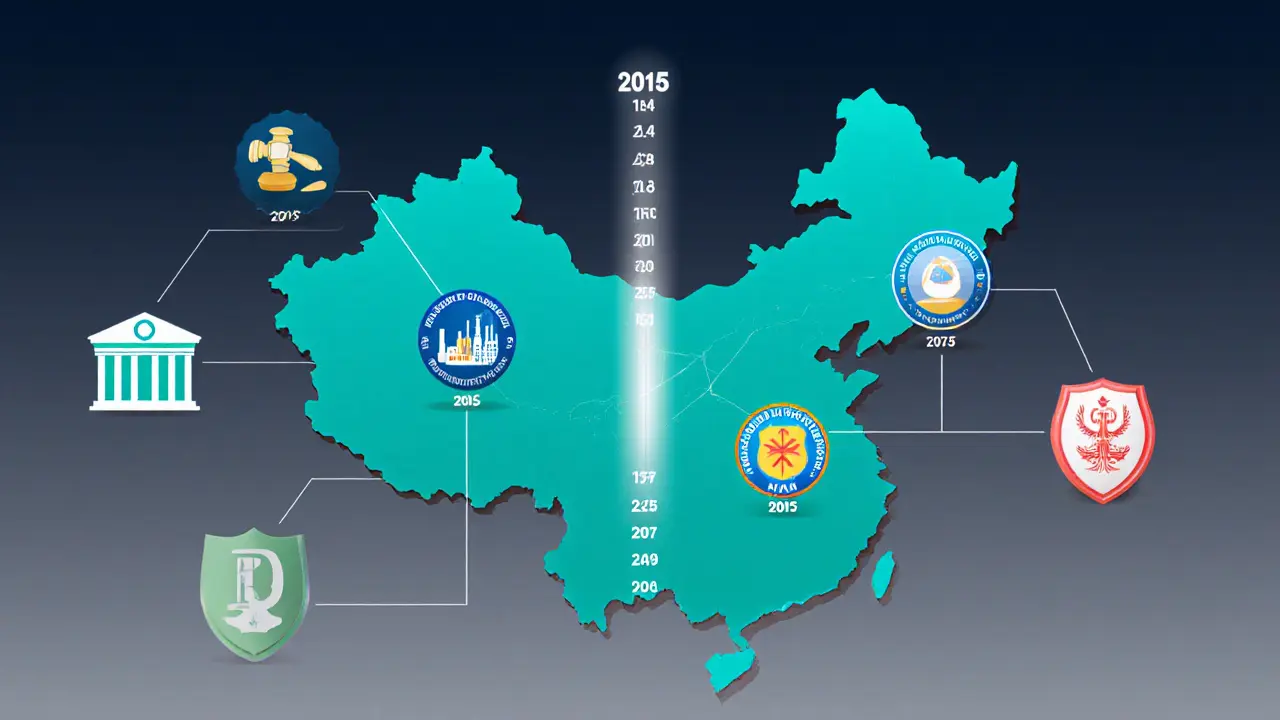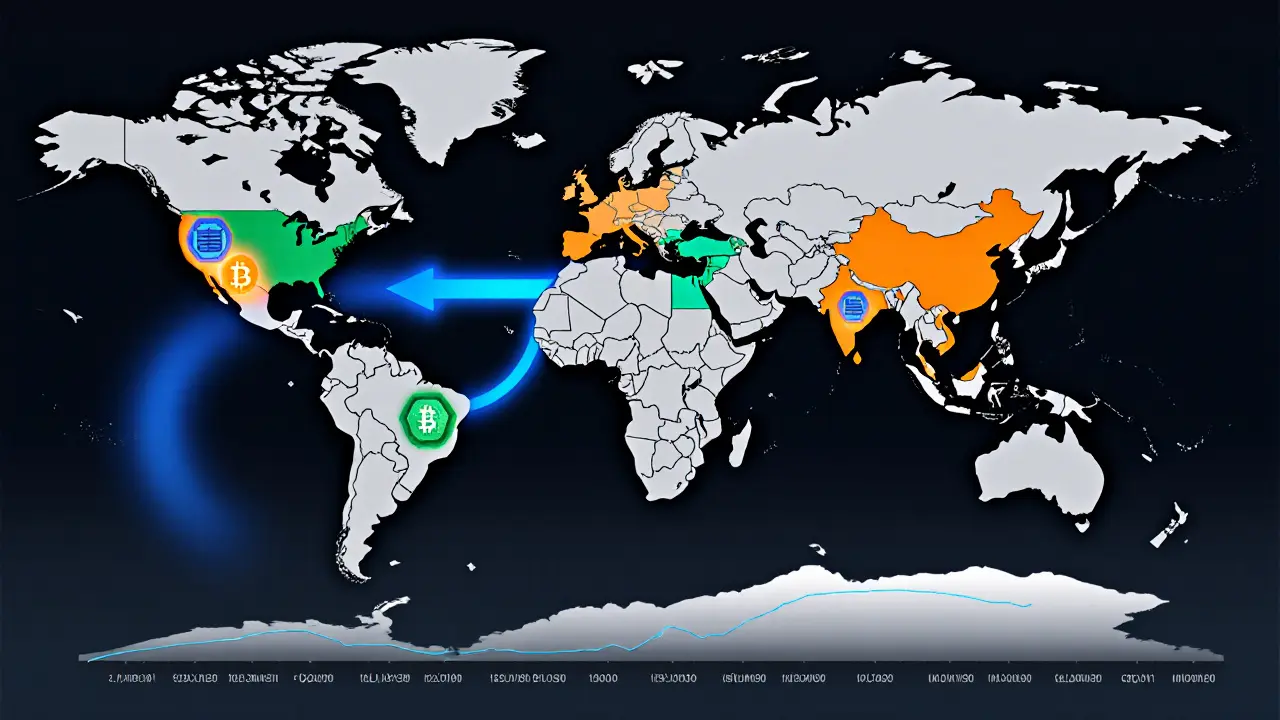Apr 24, 2025, Posted by: Ronan Caverly

China Crypto Mining Ban Timeline & Impact Simulator
Current Status
As of October 2025, all forms of cryptocurrency activities in China are criminalized.
Key Enforcement Agencies
- People's Bank of China
- State Administration of Foreign Exchange
- Cyberspace Administration
- Ministry of Industry and Information Technology
| Year | Regulatory Action | Lead Agency |
|---|---|---|
| 2013 | Banned banks from processing Bitcoin transactions | People's Bank of China |
| 2017 | Prohibited Initial Coin Offerings and shut down domestic exchanges | China Securities Regulatory Commission |
| 2019 | Crackdown on large mining farms; forced relocations abroad | Ministry of Industry and Information Technology |
| 2021 | Nationwide ban on cryptocurrency mining | People's Bank of China |
| 2022 | Court rulings denied civil claims related to crypto losses | Supreme People's Court |
| 2023 | Allowed blockchain platforms only under central oversight | Cyberspace Administration |
| 2024 | Systematic arrests and asset seizures of illegal miners | State Administration of Foreign Exchange & Ministry of Industry |
| 2025 | Comprehensive criminal ban on mining, trading, and ownership | People's Bank of China (lead) |
Reasons Behind the Ban
- Energy Consumption: Mining consumes enormous amounts of electricity, conflicting with carbon-neutral goals.
- Financial Control: Decentralized currencies challenge monetary policy and central bank authority.
- Illicit Activity: Risk of money laundering and illegal capital flows.
- Digital Yuan Promotion: Supporting state-backed e-CNY requires a controlled digital landscape.
Global Hashpower Shift
After China’s 2025 ban, global hashpower redistributed dramatically:
- United States: ~18%
- Canada: ~12%
- Kazakhstan: Short-term surge
- Norway & Iceland: Renewable energy-driven growth
Market Impact: On May 31, 2025, Bitcoin dropped from $111,000 to $104,500, with a $750M market cap loss in 24 hours.
Underground Mining Risks
Despite the ban, some underground operations persist:
- Power usage analytics detect unusual consumption patterns.
- Financial investigations trace payouts to flagged bank accounts.
- AI-driven network monitoring detects mining protocols in traffic.
Operational costs now outweigh potential profits.
When we talk about cryptocurrency mining in China is the practice of using computer hardware to validate blockchain transactions and earn digital coins, an activity that the Chinese government has progressively outlawed since 2013, the story reads like a legal roller‑coaster. By May312025 China declared a “comprehensive ban on all cryptocurrency activities,” turning what was once the world’s biggest mining hub into a criminal offense. This article unpacks the current legal status, the agencies behind enforcement, the reasons driving the crackdown, and what the ban means for the global mining ecosystem.
Key Takeaways
- As of October2025, any form of crypto mining, trading, or ownership in China is a criminal offense.
- The ban is enforced by multiple agencies, notably the People's Bank of China, the State Administration of Foreign Exchange, and the Cyberspace Administration.
- Energy consumption, financial risk, illegal capital flows, and promotion of the digital yuan drive the policy.
- China’s crackdown forced a massive shift of hash power to the United States, Canada, Kazakhstan, and other crypto‑friendly regions.
- Underground mining persists but faces escalating detection methods and severe penalties.
Regulatory Timeline: From Caution to Criminalization
| Year | Regulatory Action | Lead Agency |
|---|---|---|
| 2013 | Banned banks from processing Bitcoin transactions | People's Bank of China |
| 2017 | Prohibited Initial Coin Offerings and shut down domestic exchanges | China Securities Regulatory Commission |
| 2019 | Crackdown on large mining farms; forced relocations abroad | Ministry of Industry and Information Technology |
| 2021 | Nationwide ban on cryptocurrency mining | People's Bank of China |
| 2022 | Court rulings denied civil claims related to crypto losses | Supreme People's Court |
| 2023 | Allowed blockchain platforms only under central oversight | Cyberspace Administration |
| 2024 | Systematic arrests and asset seizures of illegal miners | State Administration of Foreign Exchange & Ministry of Industry |
| 2025 | Comprehensive criminal ban on mining, trading, and ownership | People's Bank of China (lead) |
Why China Said ‘No’ - The Four Pillars of the Ban
The crackdown rests on four articulated concerns:
- Energy consumption: Bitcoin mining alone can chew through tens of terawatt‑hours a year, clashing with China’s carbon‑neutral targets.
- Financial control: Decentralized tokens bypass the People’s Bank of China’s monetary policy, creating systemic risk.
- Illicit activity: Cryptocurrencies are linked to money laundering, capital flight, and other illegal capital flows.
- Digital yuan promotion: The state‑backed digital yuan (e‑CNY) needs a clean policy environment without competing decentralized assets.

Enforcement Mechanics - How the Ban Is Policed
Multiple bodies work in tandem:
- People's Bank of China monitors banking channels, ensuring no crypto‑related payments slip through.
- The State Administration of Foreign Exchange tracks cross‑border fund movements that could finance mining.
- The Cyberspace Administration scans internet traffic for mining software signatures.
- The Ministry of Industry audits electricity grids, flagging abnormal power spikes that suggest hidden mining rigs.
When an anomaly is spotted, a coordinated raid can result in equipment seizure, fines, and criminal charges that carry up to several years in prison.
Underground Mining - Still Alive, But Risky
Despite the ban, small‑scale, covert operations linger in remote provinces. They often hide rigs in industrial warehouses, agricultural facilities, or even residential basements, using recycled hardware to stay under the radar. However, these setups face three escalating threats:
- Power‑usage analytics can pinpoint abnormal consumption patterns within minutes.
- Financial investigators trace cryptocurrency payouts back to bank accounts flagged for “high‑risk” activity.
- The government has begun deploying AI‑driven network monitoring to detect mining protocols embedded in normal traffic.
For operators, the cost‑benefit equation is rapidly tipping toward closure.
Global Ripple Effect - Where Did the Hashpower Go?
Before the 2021 ban, China contributed roughly 65% of the world’s Bitcoin hashrate, thanks to cheap coal‑derived electricity and proximity to hardware manufacturers. After the 2025 ban, the following trends emerged:
- United States: Hashrate share rose to ~18%, driven by Texas and Wyoming’s favorable policies.
- Canada: Benefited from abundant hydro power, now holding ~12% of global hashrate.
- Kazakhstan: Experienced a short‑term surge but faces its own power‑supply instability.
- Norway & Iceland: Grew modestly thanks to renewable energy incentives.
Market reaction was immediate. On the day of the May312025 announcement, Bitcoin slipped from $111,000 to $104,500, and the total crypto market cap lost over 10% in 24hours, wiping out roughly $750million in long positions.
Future Outlook - No Sign of Relaxation
Analysts agree that China’s stance will stay firm. The government continues to pour resources into the digital yuan, and the legal text of the 2025 ban categorizes violations as “criminal offenses,” implying heavier penalties and more sophisticated detection tools. For the global mining community, the lesson is clear: regulatory risk can reshape the entire ecosystem overnight, making diversified jurisdiction strategies a must‑have.

Frequently Asked Questions
Is cryptocurrency mining legal anywhere in China now?
No. As of October2025, mining, trading, and even private ownership of digital assets are classified as criminal offenses throughout the entire country.
What agencies enforce the crypto mining ban?
The lead agency is the People's Bank of China, working with the State Administration of Foreign Exchange, the Cyberspace Administration, and the Ministry of Industry.
Why did China focus on energy consumption in its rationale?
Bitcoin mining can consume as much electricity as a small country. This clashes with China's pledge to hit carbon neutrality by 2060, so cutting energy‑hungry mining aligns with environmental policy.
Can I still buy Bitcoin on a Chinese exchange?
No. All domestic exchanges were shut down in 2017, and the 2025 ban bars any crypto‑related financial service, including exchange operations.
What happens to miners caught operating illegally?
Authorities typically seize equipment, freeze any related bank accounts, and prosecute individuals. Penalties range from hefty fines to several years of imprisonment.
Write a comment
Comments
Drizzy Drake
Hey folks, I get why the China crypto mining ban feels like a massive shake‑up for the whole ecosystem, and I’m here to break it down with a bit of empathy and a splash of optimism. First off, the sheer scale of the crackdown shows how seriously governments can act when energy consumption and financial stability are on the line. That said, miners everywhere are learning to pivot faster than ever before, and many are already scouting greener jurisdictions. The United States and Canada, with their abundant renewable resources, are stepping up, offering a lifeline to displaced hashpower. While the headlines scream “catastrophe,” the reality on the ground is more nuanced – some operations simply close, while others migrate and upgrade their hardware. It's also a reminder that the crypto space thrives on adaptability; those who cling to a single region are bound to feel the sting. For the average investor, diversifying across multiple exchanges and regions can cushion the blow. Regulators worldwide are watching China’s move and may tighten their own rules, but many are also crafting clearer guidelines to avoid a repeat of this chaos. If you’re a miner, consider partnering with local utilities that champion clean energy – it reduces risk and aligns with global decarbonisation goals. For developers, it’s a cue to design protocols that are less energy‑hungry, which could future‑proof the industry. Communities on Reddit and Discord are already swapping tips on legal compliance and alternative setups, so lean into that knowledge pool. Remember, the narrative isn’t just about loss; it’s also about the new opportunities that arise when old doors close. Keep an eye on emerging hubs in Texas, Iceland, and even emerging markets that are crafting crypto‑friendly policies. Most importantly, stay calm, stay informed, and support one another – the crypto community’s strength lies in its solidarity. Together, we can turn this regulatory wave into a catalyst for smarter, greener crypto innovation. If you’re feeling overwhelmed, take a breath and break down the situation into bite‑size pieces; you’ll find the path forward clearer than you think. Finally, I’m rooting for you all – keep mining (legally), keep learning, and keep the conversation alive.
April 24, 2025 AT 09:49
AJAY KUMAR
China’s iron‑fisted crackdown is a bold statement that sovereignty trumps any foreign crypto hype! The world’s miners better bow to the might of a nation that refuses to bow to Silicon Valley’s whims. This isn’t just a policy – it’s a war cry for economic independence, a thunderous rejection of decentralised chaos. Every rig pulled from Chinese soil feels like a victory parade for national pride. If you think the global hashpower will crumble, you’re missing the fire that fuels true patriotism. Let the rest of the world scramble; China’s resolve is unbreakable and the future belongs to those who respect it!
April 29, 2025 AT 08:37
bob newman
Oh sure, the official story “energy consumption” is just a cover for the elite’s secret plan to hoard all the Bitcoin for themselves. They want you to believe it’s about climate while they’re quietly siphoning off the remaining hashpower to offshore accounts. Didn’t you notice the timing? Right after the 2025 elections, the same bureaucrats who love central control suddenly become crypto crusaders. It’s all a grand chess game, and we’re just the pawns moving the mining rigs. Keep an eye on the “transparent” reports – they’re probably written in code for the shadow consortium.
May 4, 2025 AT 07:25
Anil Paudyal
its just another ban.
May 9, 2025 AT 06:13
Kimberly Gilliam
the collapse of this whole crypto era is inevitable the ban seals the fate of miners everywhere no redemption in sight
May 14, 2025 AT 05:01
Jeannie Conforti
hey i think its actually a chance for miners to find greener ways and for us to learn about clean energy options lol
May 19, 2025 AT 03:49
tim nelson
you’re right but don’t forget the risk is real and anyone ignoring that is being reckless we need to act fast and protect our assets
May 24, 2025 AT 02:37
Zack Mast
the ban is more than a policy it’s a metaphor for humanity’s endless quest to control the uncontrollable the universe whispers that freedom cannot be chained yet we bind it in legislation
May 29, 2025 AT 01:25
Dale Breithaupt
keep pushing forward we’ll find new horizons and keep the spirit alive
June 3, 2025 AT 00:13
Rasean Bryant
the data clearly shows a redistribution of hashpower that, while initially disruptive, creates diversification opportunities for miners willing to adapt
June 7, 2025 AT 23:01
Angie Food
yeah sure, diversification is just a fancy word for chaos and loss for anyone who believed in crypto stability
June 12, 2025 AT 21:49
Jonathan Tsilimos
the regulatory trajectory delineates a paradigm shift in digital asset governance fostering compliance frameworks that integrate cryptographic proof mechanisms with statutory oversight
June 17, 2025 AT 20:37
jeffrey najar
basically what that means is you’ll see more clear rules coming, which should make it easier for legit miners to stay on the right side of the law and avoid surprises
June 22, 2025 AT 19:25
Rochelle Gamauf
while the articulation is commendable the reality remains that excessive regulation stifles innovation and imposes undue burdens on forward‑thinking enterprises
June 27, 2025 AT 18:13
Jerry Cassandro
anyone know how the hashrate numbers are actually measured after the big migration? curious about the methodology
July 2, 2025 AT 17:01
Parker DeWitt
🤔 honestly the stats are probably inflated by Western media to make China look bad, keep questioning everything 🤷♂️
July 7, 2025 AT 15:49
Allie Smith
we can look at this as a chance to grow smarter together, learning from the past while we build a brighter future for all miners
July 12, 2025 AT 14:37
Lexie Ludens
oh please, another feel‑good post while the reality is miners are losing everything and the market is on the brink of disaster
July 17, 2025 AT 13:25
Aaron Casey
understanding the cultural context behind China’s decision helps us appreciate the balance they seek between economic growth and environmental stewardship, and it underscores the need for global collaboration in establishing sustainable mining practices
July 22, 2025 AT 12:13
Leah Whitney
that’s a solid point, let’s also explore how other countries can share best practices without compromising their own energy policies
July 27, 2025 AT 11:01
Lisa Stark
in the grand scheme, every regulatory wave is a reminder that technology and governance are intertwined, each shaping the other in an endless dance of adaptation

Author
Ronan Caverly
I'm a blockchain analyst and market strategist bridging crypto and equities. I research protocols, decode tokenomics, and track exchange flows to spot risk and opportunity. I invest privately and advise fintech teams on go-to-market and compliance-aware growth. I also publish weekly insights to help retail and funds navigate digital asset cycles.